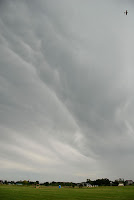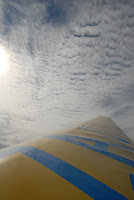The weekend weather forecasts are starting to sound like a broken record. A bad broken record. We had low ceilings, rain, thunderstorms, winds and whatever else Mother Nature could throw the way of hapless glider pilot.
The weekend of June 5-6 was not supposed to be an exception. The front was supposed to come through and the forecast showed no chance of flying at all. But miraculously the skies cleared up some by about 10am and completely by mid-day on Saturday. This was a real blessing as that was the date of my club’s first open house in many years.


Seeing the weather improve rapidly on Saturday, I considered getting my own glider out of the hangar and practicing some short field landings, but decided against it as the lineup was very busy with intro flights for the open house. Instead, I decided to play with my newly acquired 18-200mm zoom lens and take pictures for the club’s and my own websites. I took pictures of people, tow planes, gliders in motion and of course the skies.

The afternoon sky had deep iridescent blue color that often accompanies weather changes and the occasional clouds had very interesting shapes that only unsettled sky can produce. At some point, there was a rainbow amidst the clouds, a sign of the warm front approaching.

As the day wound up, I had an urge to go up and look at that unsettled sky from above. But I did not want to fly myself; I wanted to be a spectator with the camera. In the luck of perfect timing, the moment I realized I wanted to go up, I was picking up a glider that just landed and pulling it back to flight line. And it was not the ordinary glider, it was privately owned LK-10, a WW2 vintage glider that has an open cockpit for the passenger. I asked the owner if he would take me up and he agreed.


By the time we were on a line waiting to take off, the approaching front line was visible from the ground. The take off with the open cockpit was noisy and exciting at the same time. Things got quieter after the release and the sensation of flight and moving through the air was beyond words. We did not expect to fund any lift that time of the day with a front approaching, but surprisingly we flew into rising air and circled in there for a while. We were joined in the thermal by a bird and another glider.


As we circled, I had a real good look at the skies. The skies to the east and north of us were blue with some feather clouds that created amazing patterns.
The upcoming front was now closer and the skies to the west and south of us were ominous with dark clouds pregnant with rain or thunder.
The settling sun was almost completely covered by clouds but a few remaining rays added some color to the spectacle that left me speechless and lost in time and space.


Eventually we ran out of lift and came down to earth. As I climbed out of the glider, I looked up and noticed that the clouds overhead formed into impressive mammatus formation. Very vague thought at the back of my mind briefly surfaced to remind me that mammatus clouds are often associated with very fierce storms, but in the routine hassles of stacking the gliders I completely forgot about it until the next morning when I read that the front we were watching resulted in tornado hitting a town southwest of us…











